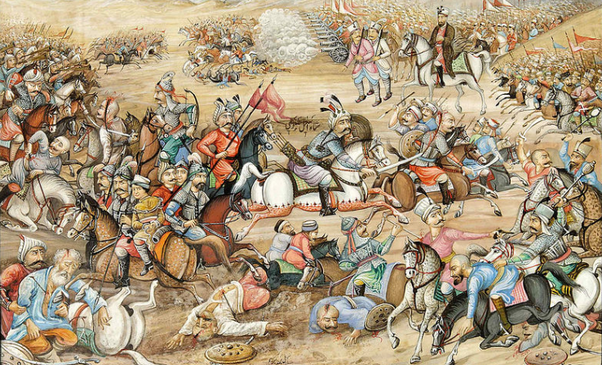1723-1727 Ottoman-Safavid War in Ottoman Perspective

1723-1727 Ottoman-Safavid War in Ottoman Perspective

Ahmed III. (Credit: Wikipedia)
The Ottoman Empire and Safavid Dynasty were two of the striking factions since the creation of the world. Their struggle which started with the Battle of Çaldıran in 1514 continued to the last Ottoman-Persian conflict in the early 19th century. Possessing the advantageous position of occupying the vast territories of the Middle East and other Persian territories always attracted the Ottoman Empire in order to fix the precarious circumstances of its economy and authority. In the early mid 18th century, Ottoman Empire failed to maintain its domination throughout European territories while the Anatolian mainland changed from the land of security to the place of rebellions. In 1639, Ottoman Empire retained its administrative force towards Persian lands positively, although the unsuccessful attempts in European mainland. Indeed, the erratic situation of the Safavid Dynasty caused it to be unable to engage Ottoman diplomacy forcing it to concentrate on inner issues more. That is to say, it is quite crucial to assess the general situations of these two empires before the war, the causes, ongoing situation and results of the war to understand this topic well.
General Situation of The Two Empires Before The War

Safavid Flag (Credit: Wikipedia)
The general circumstances of the Ottoman and Safavid empires ought to be evaluated deeply for investigating the topic well. The general situation of Ottoman Empire before the war was quite precarious in terms of violating agreements with European monarchies and some exceptions like the Prut Campaign War in 1711. Also, the occurrence of the Tulip Era which reduced warfare specified the seniority of European art and literature applying for good. Moreover, the precarious authority in Persian mainland had reached its peak point when Hotakis from Afghanistan attacked the Safavid territories. Upon this invasion, Safavid Shah Sultan Husayn could not defend the capital of his empire, Isfahan. The heir of Sultan Husayn, Tahmasb II sought a way to save his territories from invaders from the east. Thus, he sent an envoy to Istanbul to establish his sovereignty in Tabriz. In order to secure its eastern borders, Ottoman Empire supported the authority of Tahmasb at first. However, the actions of Russian troops from the northern side of the Azerbaijan territories, also having the opportunity to recapture old given lands from the Middle Eastern Plateau made the Ottomans intervene this war. On the other hand, Safavid domination lost its influence after the rule of Shah Abbas who entailed the downfall of Safavid authority. Furthermore, the start of Afghan invasions from the eastern borders definitely damaged the Safavid Empire. Especially, conquering of Safavid capital, Isfahan, by Afghan leader Mir Mahmud Khan demonstrated the period of suffering the collapse in Persian mainland. These conflicts prepared the basis of Ottoman-Safavid or Ottoman-Hotaki war strictly. To sum up, the general situation of the Safavid and Ottoman dynasties should be assessed greatly for handling the topic well.
The Causes of The War

Coin of Shah Tahmasb II. (Credit: Wikipedia)
Firstly, the causes of the war are quite significant to understand the Ottoman perspective exactly. From the Turkish perspective, it was seen as the dominator from which weak people always requested for help. In an objective approach, it can be said that one of the causes of the war was the calling for help from Iranian dwellers. Next, the chaotic situation resulted from the Treaty of Passarowitz in 1718 was an another cause. Perceiving the power of the Ottoman Empire was not the same as the period that mid 17th century, and this made Ottomans retreat from European warfare for the short term. This is because, Ottomans had to deal with the problems of Eastern region competently, though it was in the Tulip Era. In terms of Ottoman authority, the treaties of both Karlowitz and Passarowitz were humiliating. The terms that were signed vanquished the territorial expansion and diplomatic sufficiency of Ottoman Empire. In order to remove this bad luck upon the state structure, this war was seen as a necessary attempt for returning to old powerful years. Also, it can be evaluated that allying with Russian Empire under the command of Peter the Great could have led up to a long term friendship in favour of Ottoman goals over the European territories. Finally, the request to benefit from the precarious situation of Safavid Rule was the last reason. Ottoman Empire asked to occupy the areas where were taken by Abbas I. In addition, inhibition the new Hotaki rule over the Safavid territories was in favour of Ottoman Empire. In a depth investigation, none of these states wanted a new powerful regime around their territories. Therefore, Ottoman Empire wanted to secure its fronts through eliminating the new Hotaki rulership and retaking its old lands from the Safavid Dynasty.
The Ongoing Events and Finish of The War
The Ottoman Empire declared a war against the Safavid Dynasty in 1723 through attacking the territories in Azerbaijan and Eastern Anatolia. By the way, Russian Empire also launched an attack from the northern part of Azerbaijan and took Baku as well. Thus, the conflict between Russia and Ottomans was inevitable. However, thanks to the intervention of France and England, the treaty of Constantinople which contained the division of Safavid lands was agreed between Russia and Ottoman Empire in 1724. Securing the Russian front, Ottoman Empire was able to attack Safavid lands decisively. Since Ottoman Empire was fighting on only one border, Ahmed Pasha, who was the commander of Ottoman army, could conduct the soldiers very well. Nihavand, Nahcivan, Kermanshah, Gence were taken by Ottoman army. Besides, the expansion of Hotaki ruler Ashraf Shah caused a war between Ottomans and Hotakis. Ashraf Shah was the successor of Mir Mahmud Khan who was proclaimed as new Iranian Shah by the order of Shah Husayn. Ashraf Shah who maintained the Sunni belief same as the Ottomans could have been a friend of the Ottomans. On the contrary to this point, Ottoman Empire had no function to engage in a new powerful dynasty in Iranian plateau. Therefore, Ottoman Empire under the rule of Ahmed III decided to entitle Ashraf Shah as the invader of the Safavid mainland while he was considered as the real owner. Eventually, these two powers collided each other in Ancidan War where Ottoman Army was destroyed by the Afghan-Persian army under the leadership of Ashraf Shah. Even though Ashraf Shah defeated Ottomans and won the battle, in terms of diplomacy, Ottoman Empire obtained a decisive victory.
Results of The War
Aftermath of the Andican War, the treaty of Hamedan was agreed between Ottomans and Ashraf Shah. According to this treaty, Ottoman Empire retained its occupations such as Kirmanshah, Hamedan, Luristan, Nihavend, Tabriz, Qarabakh and other Azerbaijani cities, and Ashraf Shah was recognized as the sole ruler of Persian mainland. The peace process was interrupted by Nader Shah who was the vizier of Shah Tahmasb II, and he retook Isfahan from Ashraf Shah. Safavid Dynasty that constructed its authority thanks to Nader Shah, defeated Ashraf Shah and did not recognize the treaty of Hamedan which caused an another Ottoman-Safavid war between 1730 and 1732.
- Ottoman sovereignty over all the western and northwestern parts of Iran (including most of Tabriz, Hamadan, Kermanshah, Lorestan and most of the South Caucasus).
- gave Ashraf Hotaki official recognition as Shah of Persia.
- gave Ashraf Hotaki rights of minting coins.
- gave Ashraf Hotaki rights of sending annual pilgrimage caravans to Mecca.
Conclusion
As a result, the 1723-1727 Ottoman-Safavid or Hotaki war was quite effective warfare. The causes, ongoing situations and results are quite significant for understanding the Ottoman perspective over the Persian mainland and Safavid Dynasty. The struggle between these two empires continued until the 19th century that modern boundary was accepted 1639 Treaty of Zuhab.
Sources;
- Uzunçarşılı, İsmail Hakkı. “Osmanlı Tarihi IV. Cilt I. Kısım”, Turkey/Ankara: Türk Tarih Kurumu publishing, 2009.
- Finkel, Caroline. “Osman’s Dream: The History of the Ottoman Empire”, United States/NY: Basic Books, 2006.









